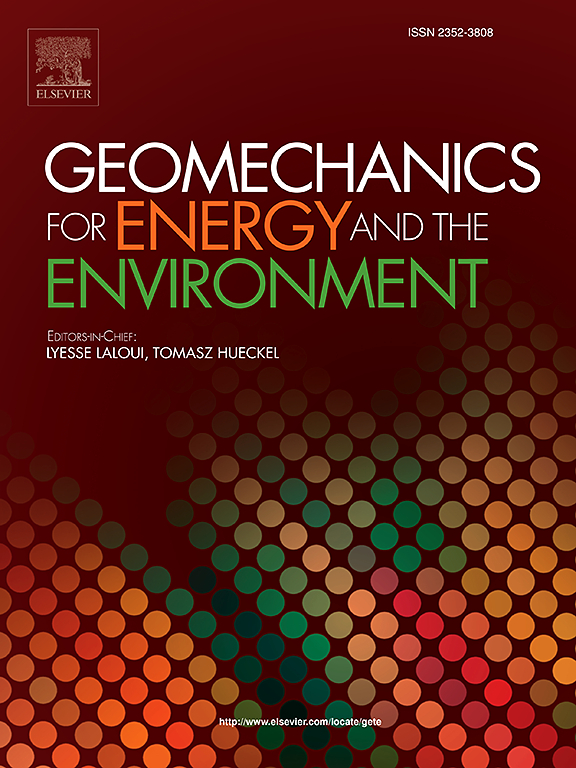Safety assessment for a geological disposal facility in domal salt: The Dutch case
IF 3.3
2区 工程技术
Q3 ENERGY & FUELS
引用次数: 0
Abstract
In the Netherlands, all radioactive waste is currently collected and stored above ground for at least 100 years by COVRA. After 100 years, all radioactive waste must be permanently disposed of. One option for permanent disposal currently considered is a purpose-built geological disposal facility in rock salt, where a combination of natural and engineered barriers is expected to provide the necessary safety. Rock salt, as a natural barrier, is considered impermeable when undisturbed. Therefore, radionuclides can only reach the surface via the mined openings of the geological disposal facility. Here, multiple engineered barriers provide the necessary safety. In the short term, these include concrete seals, HLW packages, and waste forms. In the long term, moisturized granular salt backfill provides containment. Here, we present the safety assessment of a geological disposal facility in rock salt, using the updated Dutch disposal concept and waste inventory. In total, seven different scenarios are modelled: the (1) normal evolution scenario in which the geological disposal facility evolves as expected, and six alternative scenarios: failure of (2) the high level waste packages, (3) failure of the tunnel seals, (4) failure of the spiral ramp seal, (5) flow path between a brine pocket and mine excavations, (6) less probable characteristics of radionuclide mobilization and transport, (7) and reduced long-term sealing by backfill. Model results show that when the geological disposal facility evolves as expected, no release of radionuclides is expected. Likewise, no release is expected in the six alternative scenarios, although differences exist in the extent to which radionuclides are able to travel within the geological disposal facility. These results indicate that the engineered barriers, combined with the natural barrier of the rock salt, are effective in isolating and providing containment during at the least the first million years after closure.
多金属盐地质弃置设施的安全评估:荷兰案例
在荷兰,目前所有放射性废物都由COVRA收集并储存在地面上至少100年。100年后,所有放射性废物必须永久处理。目前考虑的永久处置的一种选择是在岩盐中建造一个专门的地质处置设施,在那里自然和工程屏障的结合有望提供必要的安全性。岩盐作为一种天然屏障,在不受干扰的情况下被认为是不透水的。因此,放射性核素只能通过地质处置设施的开口处到达地表。在这里,多个工程屏障提供了必要的安全性。在短期内,这些包括混凝土密封,高铁包装和废物形式。从长远来看,湿润的颗粒盐回填提供了密封。在这里,我们提出了岩盐地质处置设施的安全评估,使用更新的荷兰处置概念和废物清单。总共模拟了7种不同的情景:(1)地质处置设施按预期发展的正常演变情景,以及6种备选情景:(2)高放废物包的破坏,(3)隧道密封的破坏,(4)螺旋坡道密封的破坏,(5)盐水袋和矿山开挖之间的流动路径,(6)放射性核素的不太可能的移动和运输特征,(7)和回填减少长期密封。模型结果表明,当地质处置设施按预期发展时,预计不会有放射性核素的释放。同样,尽管放射性核素能够在地质处置设施内传播的程度存在差异,但预计在六种备选方案中也不会发生释放。这些结果表明,工程屏障与岩盐的天然屏障相结合,至少在关闭后的第一个百万年内有效地隔离和提供遏制作用。
本文章由计算机程序翻译,如有差异,请以英文原文为准。
求助全文
约1分钟内获得全文
求助全文
来源期刊

Geomechanics for Energy and the Environment
Earth and Planetary Sciences-Geotechnical Engineering and Engineering Geology
CiteScore
5.90
自引率
11.80%
发文量
87
期刊介绍:
The aim of the Journal is to publish research results of the highest quality and of lasting importance on the subject of geomechanics, with the focus on applications to geological energy production and storage, and the interaction of soils and rocks with the natural and engineered environment. Special attention is given to concepts and developments of new energy geotechnologies that comprise intrinsic mechanisms protecting the environment against a potential engineering induced damage, hence warranting sustainable usage of energy resources.
The scope of the journal is broad, including fundamental concepts in geomechanics and mechanics of porous media, the experiments and analysis of novel phenomena and applications. Of special interest are issues resulting from coupling of particular physics, chemistry and biology of external forcings, as well as of pore fluid/gas and minerals to the solid mechanics of the medium skeleton and pore fluid mechanics. The multi-scale and inter-scale interactions between the phenomena and the behavior representations are also of particular interest. Contributions to general theoretical approach to these issues, but of potential reference to geomechanics in its context of energy and the environment are also most welcome.
 求助内容:
求助内容: 应助结果提醒方式:
应助结果提醒方式:


